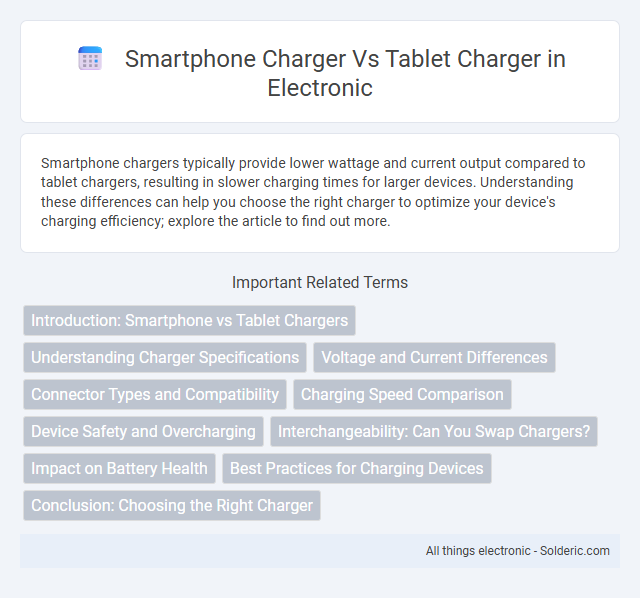Smartphone chargers typically provide lower wattage and current output compared to tablet chargers, resulting in slower charging times for larger devices. Understanding these differences can help you choose the right charger to optimize your device's charging efficiency; explore the article to find out more.
Comparison Table
| Feature | Smartphone Charger | Tablet Charger |
|---|---|---|
| Power Output | 5W to 20W | 10W to 30W+ |
| Charging Speed | Standard to Fast Charging (up to 50% in 30 mins) | Faster Charging (up to 70% in 30 mins) |
| Connector Type | USB-A or USB-C | Usually USB-C |
| Compatibility | Smartphones only | Tablets and some smartphones |
| Voltage | 5V typical | 5V to 20V (variable) |
| Size & Weight | Smaller, compact | Larger, heavier |
| Price | Lower cost | Higher cost |
Introduction: Smartphone vs Tablet Chargers
Smartphone chargers typically deliver 5 to 20 watts of power, optimized for smaller batteries and faster charging cycles. Tablet chargers often provide higher wattage, ranging from 10 to 30 watts or more, to efficiently charge larger battery capacities. The power output disparity reflects the distinct energy demands and charging speeds required by smartphones and tablets.
Understanding Charger Specifications
Smartphone chargers typically provide lower wattage, ranging from 5W to 20W, whereas tablet chargers offer higher power output, often between 18W and 30W or more, to accommodate larger batteries. Your device's charging speed depends on matching the charger's voltage and amperage to its specifications, ensuring efficient and safe power delivery. Using a tablet charger for a smartphone can be safe if the voltage matches, but it may not improve charging speed if the phone's maximum power intake is lower.
Voltage and Current Differences
Smartphone chargers typically output 5 volts with a current ranging from 1 to 2.4 amps, suitable for smaller batteries and faster, safer charging cycles. Tablet chargers provide higher voltage options, often 5 to 12 volts, and higher current outputs up to 3 amps or more to accommodate larger battery capacities and faster charging times. Understanding these voltage and current differences is crucial for ensuring device compatibility and preventing damage during charging.
Connector Types and Compatibility
Smartphone chargers commonly use USB-C or Lightning connectors, while tablet chargers may also include USB-C but often support higher wattage for faster charging. Compatibility depends on the connector type and power delivery standards, with USB-C enabling universal use across many devices, whereas proprietary connectors like Apple's Lightning are limited to specific products. Using the right charger ensures optimal performance and prevents potential damage caused by incompatible voltage or connector mismatches.
Charging Speed Comparison
Smartphone chargers typically deliver lower power output, ranging from 5W to 25W, while tablet chargers often provide higher wattage, between 10W and 30W or more, enabling faster charging for larger batteries. Charging speed depends on the charger's wattage and device compatibility, with tablet chargers generally charging bigger batteries more efficiently but not always faster for smartphones. Using Your smartphone with a charger designed for tablets may improve charging speed if the device supports higher power input; otherwise, charging speed will default to the device's maximum limit.
Device Safety and Overcharging
Smartphone chargers typically deliver lower wattage, reducing the risk of overheating and protecting battery health, while tablet chargers provide higher power designed for larger batteries but require advanced circuitry to prevent overcharging. Overcharging protection in both chargers relies on integrated smart technology such as voltage regulation and temperature control to safeguard device safety. Using a charger optimized for the specific device ensures optimal charging speed without compromising battery longevity or increasing the risk of damage.
Interchangeability: Can You Swap Chargers?
Smartphone chargers and tablet chargers differ primarily in power output, with tablet chargers typically delivering higher wattage to support larger batteries. Swapping chargers is generally possible, but using a smartphone charger for a tablet may result in slower charging times due to lower power delivery, while a tablet charger can safely charge a smartphone if the voltage specifications match. It is essential to check compatibility with USB standards and device requirements to avoid potential damage or inefficiency.
Impact on Battery Health
Using a tablet charger on a smartphone can lead to faster battery degradation due to higher voltage or amperage than typically recommended for smartphones, which may cause overheating and reduce battery lifespan. Conversely, using a smartphone charger for a tablet often results in slower charging but generally does not harm battery health, as the device draws only the power it needs. Optimizing charger compatibility by using manufacturer-recommended wattage and voltage specifications minimizes stress on lithium-ion batteries and prolongs device longevity.
Best Practices for Charging Devices
Using the appropriate charger for each device ensures optimal charging speed and battery health; smartphone chargers typically provide lower wattage (5W-20W) suited for small batteries, while tablet chargers deliver higher power (18W-30W or more) to accommodate larger battery capacities. Employing the charger designed for each device prevents overheating and prolongs battery lifespan by regulating voltage and current effectively. For best practices, avoid using a tablet charger on a smartphone or vice versa frequently, and use certified cables and adapters to maintain safe and efficient charging performance.
Conclusion: Choosing the Right Charger
Selecting the right charger depends on your device's power requirements and charging speed compatibility. Smartphone chargers typically provide lower wattage, around 5-20W, whereas tablet chargers support higher wattage, often between 18-30W or more, enabling faster and more efficient charging for larger batteries. Using the charger designed for your tablet or smartphone ensures optimal battery health and safety for your device.
smartphone charger vs tablet charger Infographic

 solderic.com
solderic.com